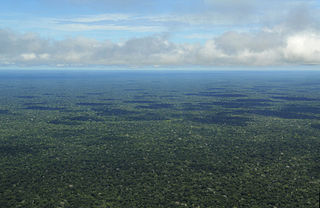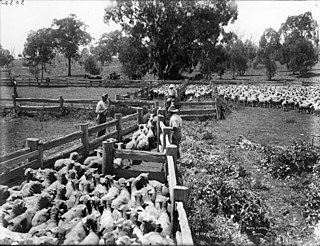Related Research Articles

Christmas Island, officially the Territory of Christmas Island, is an Australian external territory comprising the island of the same name. It is located in the Indian Ocean, around 350 kilometres south of Java and Sumatra and around 1,550 km (840 nmi) northwest of the closest point on the Australian mainland. It lies 2,600 km (1,400 nmi) northwest of Perth and 1,327 km (717 nmi) south of Singapore. It has an area of 135 square kilometres (52 sq mi).

The orca or killer whale is a toothed whale belonging to the oceanic dolphin family, of which it is the largest member. It is the only extant species in the genus Orcinus and is recognizable by its black-and-white patterned body. A cosmopolitan species, orcas can be found in all of the world's oceans in a variety of marine environments, from Arctic and Antarctic regions to tropical seas.

Madagascar, officially the Republic of Madagascar is a sovereign island country in the Indian Ocean, approximately 400 kilometres off the coast of East Africa across the Mozambique Channel. At 592,800 square kilometres (228,900 sq mi), it is the world's second-largest island country, after Indonesia. Its capital and largest city is Antananarivo.

The Philippines, officially the Republic of the Philippines, is an archipelagic country in Southeast Asia. It is situated in the western Pacific Ocean and consists of around 7,641 islands that are broadly categorized under three main geographical divisions from north to south: Luzon, Visayas, and Mindanao. The Philippines is bounded by the South China Sea to the west, the Philippine Sea to the east, and the Celebes Sea to the southwest. It shares maritime borders with Taiwan to the north, Japan to the northeast, Palau to the east and southeast, Indonesia to the south, Malaysia to the southwest, Vietnam to the west, and China to the northwest. The Philippines covers an area of 300,000 km2 (120,000 sq mi) and, as of 2021, it had a population of around 109 million people, making it the world's thirteenth-most-populous country. The Philippines has diverse ethnicities and cultures throughout its islands. Manila is the country's capital, while the largest city is Quezon City; both lie within the urban area of Metro Manila.

The platypus, sometimes referred to as the duck-billed platypus, is a semiaquatic, egg-laying mammal endemic to eastern Australia, including Tasmania. The platypus is the sole living representative or monotypic taxon of its family (Ornithorhynchidae) and genus (Ornithorhynchus), though a number of related species appear in the fossil record.

Sex is the trait that determines whether a sexually reproducing organism produces male or female gametes. Male plants and animals produce small mobile gametes, while females produce larger, non-motile ones. Organisms that produce both types of gametes are called hermaphrodites. During sexual reproduction, male and female gametes fuse to form zygotes, which develop into offspring that inherit traits from each parent.

A hedgehog is a spiny mammal of the subfamily Erinaceinae, in the eulipotyphlan family Erinaceidae. There are seventeen species of hedgehog in five genera found throughout parts of Europe, Asia, and Africa, and in New Zealand by introduction. There are no hedgehogs native to Australia and no living species native to the Americas. However, the extinct genus Amphechinus was once present in North America.

The Amazon rainforest, also called Amazon jungle or Amazonia, is a moist broadleaf tropical rainforest in the Amazon biome that covers most of the Amazon basin of South America. This basin encompasses 7,000,000 km2 (2,700,000 sq mi), of which 5,500,000 km2 (2,100,000 sq mi) are covered by the rainforest. This region includes territory belonging to nine nations and 3,344 formally acknowledged indigenous territories.

Extinction is the termination of a kind of organism or of a group of kinds (taxon), usually a species. The moment of extinction is generally considered to be the death of the last individual of the species, although the capacity to breed and recover may have been lost before this point. Because a species' potential range may be very large, determining this moment is difficult, and is usually done retrospectively. This difficulty leads to phenomena such as Lazarus taxa, where a species presumed extinct abruptly "reappears" after a period of apparent absence.

Lilium is a genus of herbaceous flowering plants growing from bulbs, all with large prominent flowers. They are the true lilies. Lilies are a group of flowering plants which are important in culture and literature in much of the world. Most species are native to the northern hemisphere and their range is temperate climates and extends into the subtropics. Many other plants have "lily" in their common names, but do not belong to the same genus and are therefore not true lilies.

Sir David Frederick Attenborough is an English broadcaster, biologist, natural historian and author. He is best known for writing and presenting, in conjunction with the BBC Natural History Unit, the nine natural history documentary series forming the Life collection, a comprehensive survey of animal and plant life on Earth.

Threatened species are any species which are vulnerable to extinction in the near future. Species that are threatened are sometimes characterised by the population dynamics measure of critical depensation, a mathematical measure of biomass related to population growth rate. This quantitative metric is one method of evaluating the degree of endangerment.

Humans are the most abundant and widespread species of primate. They are a type of great ape that is characterized by bipedalism and exceptional cognitive skills due to a large and complex brain. Humans are highly social and tend to live in complex social structures composed of many cooperating and competing groups, from families and kinship networks to political states. As such, social interactions between humans have established a wide variety of values, social norms, languages, and rituals, each of which bolsters human society. The desire to understand and influence phenomena has motivated humanity's development of science, technology, philosophy, mythology, religion, and other conceptual frameworks.

In biology, culling is the process of segregating organisms from a group according to desired or undesired characteristics. In animal breeding, it is the process of removing or segregating animals from a breeding stock based on a specific trait. This is done to exaggerate desirable characteristics, or to remove undesirable characteristics by altering the genetic diversity of the population. For livestock and wildlife, culling often refers to the act of killing removed animals based on their individual characteristics, such as their sex or species membership, or as a means of preventing infectious disease transmission.

An IUCN Red List Critically Endangered species is one that has been categorized by the International Union for Conservation of Nature as facing an extremely high risk of extinction in the wild. As of 2021, of the 120,372 species currently tracked by the IUCN, there are 8,404 species that are considered to be Critically Endangered.

Guyana, officially the Co‑operative Republic of Guyana, is a country on the northern mainland of South America. Guyana is an indigenous word which means "Land of Many Waters". The capital city is Georgetown. Guyana is bordered by the Atlantic Ocean to the north, Brazil to the south and southwest, Venezuela to the west, and Suriname to the east. With 215,000 km2 (83,000 sq mi), Guyana is the third-smallest sovereign state by area in mainland South America after Uruguay and Suriname, and is the second-least populous sovereign state in South America after Suriname; it is also one of the least densely populated countries on Earth. It has a wide variety of natural habitats and a very high biodiversity.
Leleupaussus is a genus of beetle in the family Carabidae, with only one recognized species: L. tetramerus described by Luna de Carvalho in 1962.
Anillotarsus is a genus of ground beetles in the family Carabidae. This genus has a single species, Anillotarsus tetramerus.

The saddle cichlid is a species of cichlid from the tribe Cichlasomatini, part of the subfamily Cichlasomatinae from South America. It is the type species of the genus Aequidens. It is reasonably common in the aquarium trade.
References
- ↑ "Paussina", Tree of Life , 2009. Retrieved February 22, 2020.
- 1 2 Hermani, Henry. Social Insects, Volume 3, Elsevier , December 2, 2012. Pg. 50. Retrieved February 22, 2020.